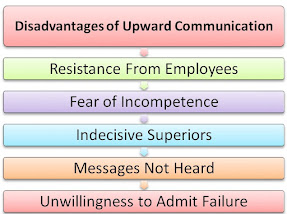FORMAL COMMUNICATION CHANNELS
1)DOWNWARD COMMUNICATION
- Downward communication refers to the messages and information that proceed vertically down the chain of command from managers who communicate in a downward direction with employees that report to them.
- In other words, downward communication flows from individuals in higher levels of the organization to those in lower levels. It is arguably the most familiar and obvious flow of formal communication.
- Downward communication is used by group leaders and managers to assign goals, provide job instructions, inform employees of policies and procedures, point out problems that need attention, and offer feedback about performance.
- A communication from the general manager of a company to the branch managers is an example of downward communication.
- Other examples of communication conveyed in downward direction include annual confidential reports, performance appraisals, notices, project feedback, announcements of company policies, new company goals, job instructions and trainings, and so on.
- Forms of downward communication may include notes, notices, memos, telephone conversations, voice mails, emails, or face-to-face conversations.
The picture above shows the advantages and disadvantages of
downward communication.
2)UPWARD COMMUNICATION
- Upward communication is the flow of information from lower to higher levels in the organization’s hierarchy. Its main purpose is to provide feedback to higher-ups, inform them of progress toward goals, and relay challenges on several areas of organizational functioning.
- In particular, upward communication consists of messages sent vertically up the line from subordinates to superiors. This flow is usually from subordinates to their direct superior, then to that person’s direct superior, and so on up the organizational hierarchy.
- Openness to ideas and input from people in the lower levels of the organization is often the hallmark of an effective and successful organization. Thus, upward communication is important as much as downward communication
LATERAL/HORIZONTAL COMMUNICATION
- Horizontal communication refers to the flow of information among employees and units that are at the same hierarchical level in an organization.
- In other words, horizontal communication (also called lateral communication) refers to departments and managers on the same organizational level communicating with one another across organizational silos.
- Horizontal (or lateral ) communication is used to run departments, where it is essential to gather information across members of the same work group, across members of work groups at the same level, across managers at the same level, or across any other horizontally equivalent personnel
DIAGONAL COMMUNICATION
- Diagonal communication refers to communication that crosses both levels and functions or departments where staff members from different departments, irrespective of their reporting relationship, interact with one another within the organization.
- This kind of communication flow is increasingly the norm in organizations (in the same way that cross-functional teams are becoming more common), since it can maximize the efficiency of information exchange.
- The shortest distance between two points is a straight line. Diagonal communication routes are the straight lines that speed communications directly to their recipients, at the moment communication is necessary.
- Communications that zigzag along horizontal and vertical routes, on the other hand, are vulnerable to the schedules and availability of the individuals who reside at each level.
This is a youtube video that I recommend for you to watch.
It describes 4 types of communication channels more specifically and it is more
easy to understand.











simple and easy to understand 👍
ReplyDelete